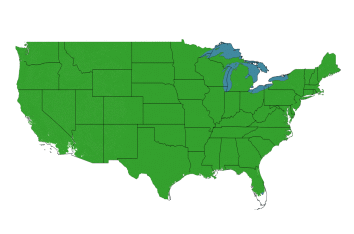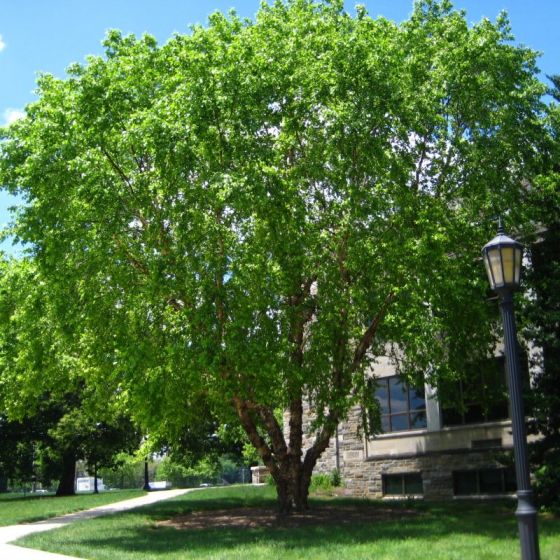✖
Gorgeous, Hardy, Fast-Growing Native River Birch
- Gorgeous, Peeling, Salmon-Pink and Cinnamon-Brown Bark
- Fast Growing
- Pyramidal Growth Habit Becomes Rounded with Age
- Native American Deciduous Tree
- Glossy Green Leaves Make A Lovely Shade Tree
- Useful as A Specimen, Screening, Natural Groups, Shelterbelts
- Most Adaptable and Heat Tolerant of the Birches
- Most Bronze Birch Borer Resistant of the Birches
- Can Grow in Moist Soils
- Can Grow in Full Sun or Partial Shade
- Rarely Bothered by Deer
The River Birch (Betula nigra) is the most planted Birch in the United States and the best one for hot climates. It is a tree that has something to offer for every season.
It's world famous for its silky, smooth, light-tan bark that peels and exfoliates to reveal tantalizing glimpses of beautiful salmon-pink and cinnamon brown-colored patches beneath. The bark is an outstanding ornamental feature.
Lovely all year long, the River Birch is truly stunning in the winter. The graceful branches and the colorful, textured bark add interest to even the darkest winter day.
In the spring, River Birch grows fresh, light green leaves and female catkins that stand up on the ends of the branches. As the diamond-shaped leaves mature in the summer, they become a beautiful, shiny, dark green.
River Birches transform again in the fall. The male catkins will emerge dripping from the branches and the leaves will turn a brilliant butter-yellow that lights up the autumn landscape.
This is the hardiest of all Birches. It's a fast-growing, trouble-free tree that is a favorite of many. Young plants can double in size in a short couple of years!
Get started on your love affair with this wonderful native tree. Order your River Birch from LetsPlantify.com today.
How to Use River Birch in the Landscape
River Birch are available in both single stem and multiple trunk clumps. Both options make specimen plants that can be used throughout the landscape in different applications.
As you can imagine, a single stem features a solitary trunk. Multiple trunk clumps usually have 3 or 4 strong leaders that emerge from a single point. Both versions are useful and can accent your landscape beautifully.
For a natural grouping, we recommend that you include both styles. Plant them 20 - 40 feet apart and vary the spacing between trees. There is nothing prettier than a meandering stand of River Birch near a water feature.
Sculpt a mounded berm in a large front yard, and include 1, 3 or 5 River Birch trees. You'll be thrilled how quickly they establish themselves and start to fill in to mature size. They'll provide a nice natural screen to obscure the view into a large picture window.
Large, robust natural groups also look great butting up against an open park or green space. Try them as a fast-growing, easy care living fence. Be sure to mulch underneath them to keep things really easy for yourself.
Tender green spring foliage is so welcome after a long winter. Highlight that special season by adding long, skinny drifts of spring flowering bulbs in the planting bed. Use a mix of Hyacinth, Daffofils and Tulips to extend the visual impact of the spring season.
River Birch make incredible, long lived, fast growing windbreaks. Don't forget to include some in your shelterbelts in front of larger evergreen trees. The bright spring foliage and vibrant fall color will be dazzling against that steady, evergreen backdrop.
Use River Birch Clumps as a super way to create the walls of specialty garden rooms. Surround an outdoor firepit with a semi-circular planting bed and underplant young trees with Densiformis Yews and Red Twig Dogwood shrubs.
They'll create a nice, private space for you by screening out neighboring houses and ugly views in a very short period of time.
River Birch is a fantastic choice for a very wide ranging set of conditions from water's edge to upland sites. Because this tree can tolerate moist soils, it should be strongly considered to include in Rain Gardens.
These are specialized designs that are created to trap water runoff from roofs and streets. Tree roots filter the potentially polluted water before it drains directly into the storm sewer and on to local rivers and streams. Use River Birch in the Mesic—or middle—Zone of the Rain Garden planting.
Municipalities are even using them as street trees. They'll tolerate extremely tough conditions without a lot of care, fuss or muss.
#ProPlantTips for Care
Although widely adaptable, River Birch will prefer a slightly acidic soil. Test your soil pH and add Sulphur before planting. You can also add a few handfuls of peat moss to the planting soil backfill when planting. Feed it Dr. Earth Acid Lovers Organic and Natural Premium Fertilizer in early spring.
To establish young trees, we recommend providing a regular amount of water. Use the Finger Test to check the soil moisture. Stick your finger into the soil near the tree up to the 2nd knuckle. Is it still moist? Skip watering that day. Is it getting dry? Time to give a nice, long drink.
Once the River Birches are established in your native soil, they are tough and rugged. They'll handle a bit of dry weather on their own. You will want to protect your investment with supplemental water in extended droughts.
In deer country, or where rabbits are present - consider creating a temporary fence around young trees. River Birch is not a favored food, but hungry animals will sample anything. Use repellent spray the first day you plant and reapply according to the directions. That's cheap insurance for your landscape investment. Once the trees reach size, they'll lose any appeal to local critters.
For pruning, wait until the River Birch tree leaves out in spring. You won't want to prune any earlier, as the sap is rising during that time. Waiting until later will help pruning cuts heal faster without dripping sap.
This tree grows very fast and can shade out smaller branches in the interior of the crown. We recommend planting it away from the patio and mulching underneath. Why not keep it easy on yourself? Using them in groups and mulched beds means you won't have to clean up beneath as frequently. The small leaves are easily bagged up in late autumn.
For a wonderful visual interest, the peeling exfoliating bark of the native River Birch are hard to beat. Their rugged bark is a perfect foil to the airy, breezy foliage and works beautifully with modern, rustic and contemporary styles.
You'll love River Birch from LetsPlantify.com. Order today!
| Botanical Name | Betula nigra |
|---|---|
| Mature Height | 25 - 50 feet |
| Mature Spread | 25 - 35 feet |
| Soil Type | Widely Adaptable |
| Moisture | Moderate, Low |
| Sun Exposure | Full Sun, Partial Shade |
| Growth Rate | Fast |
| Bloom Period | Early Spring |
| Foliage Color | Green |
| Fall Color | Yellow |
| Pollinator Required | No |
| Pollinator Friendly | Yes |
| Growing Zone Range | 3-9 |

Write Your Own Review

